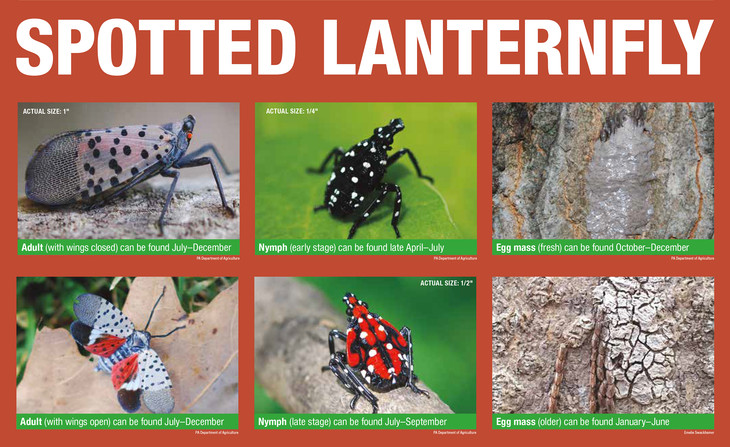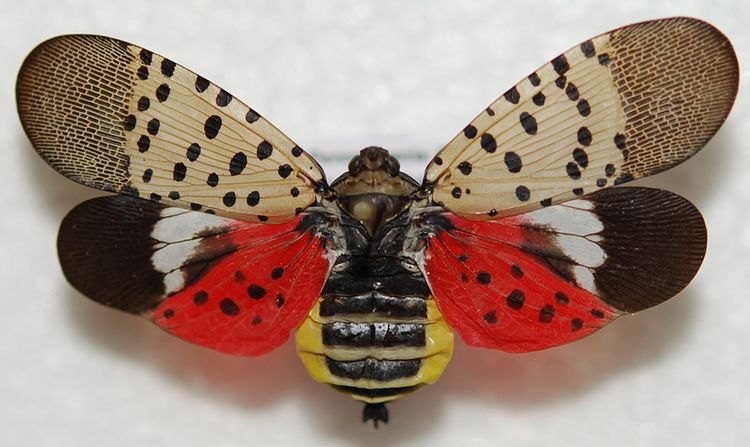By JULIE CARLE
BG Independent News
The adult spotted lanternfly is kind of pretty with its spotted wings and red underlay, but don’t let its appearance fool you. The insect, in all of its stages from nymph to adult, is considered an invasive species.
Though there have been no sightings reported yet in Wood County and only a dozen last year in Lucas County, Amy Stone, extension educator at Ohio State University Lucas County, wants people to be on the lookout this year. She talked about the spotted lanternfly as “the pest of the hour” and other invasive species during the April Ag Forum hosted by the Center for Innovative Food Technology (CIFT).
The spotted lanternfly got its start in Pennsylvania and grew prevalent throughout the state. Some of its westward expansion was natural but a lot of it was spread by humans and transportation, Stone said. In Ohio, Cuyahoga, Jefferson and Lorain counties have established populations that are reproducing.
The Tree of Heaven or Ailanthus, which is non-native in the U.S., is the primary host plant for the insects, though other fruits, ornamental and woody trees are home to them during their various stages. Originally from China, the Tree of Heaven and the spotted lanternfly evolved together in Asia. “When it found its favorite host plant in the U.S., it was almost like a homecoming,” Stone said.
The insects are more of a messy nuisance than a harmful threat. The sugars they extract from plants, with grapes being their second favorite host plant, are excreted as a sweet, sticky substance. The “honeydew” often attracts a black, sooty mold that is not dangerous to humans or plants, but could block sunlight and stunt the plant’s growth.
The key to keeping pests from becoming invasive species is to combat them before they are out of control. Stone urged people to pay attention when they are walking in parks, working in farm fields or checking trees and plants in their back yard. “If you see a spotted lanternfly at any stage, report it to someone in Ohio State University Extension, Ohio Department of Natural Resources or the Department of Agriculture.
“We can have peaks and valleys in our native species, but if no one reports when they see something they aren’t familiar with or something they’ve heard about but not seen before, the problem can build,” she said. “Most of the invasive species reported are done by residents in their backyards.”

Being aware of the pest’s general feeding schedule provides individuals with a timeline for when to look for the lanternfly
- Roses & Perennials – Only the nymphs in May and June.
- Grapes and Tree of Heaven – Nymphs in May-June-July; Adults, August-October.
- Black walnut and butternut – Nymphs in June & July; Adults, August-October.
- River birch, willow and sumac – Nymphs only in July; Adults, August-October.
- Red/silver maple – Nymphs only in May; Adults, August-October.
Stone also provided updates on two pests that were previously big problems: the emerald ash borer and the gypsy moth, now known as the spongy moth.
Emerald ash borers were identified in 2003 in northwest Ohio and quickly became an issue. Thousands of ash trees across the state were destroyed because of the pest. “If you didn’t have an ash tree yourself, you saw the devastation they did to our communities, urban and rural,” Stone said.
The pest population appears to be building again she said, urging people “to be on the lookout for thinning canopies and the small D-shaped holes in tree trunks.”
The gypsy moth infestation has been dealt with for many years. This insect was brought to the U.S. by a French scientist in the late 1800s who wanted to create silk in Massachusetts. The insects escaped and then became established as an invasive species eight years later.
Renamed the spongy moth, its eggs are hatching now, Stone said. “If you have a population of the tiny caterpillars, they will become large eating machine monsters.” Ohio is primarily in a suppression zone, which means the pests are still around but their damage is reduced.
Other invasives you may see are oriental bittersweet, the kudzu of the north, which can become prolific in woodlots; Asian jumping worms, a worm that feeds on roots of plants; Callery pear, a fast-growing tree that quickly takes over open spaces; and Beech leaf disease.
“We know that invasive species have been an issue from the beginning. We are a global society, and we continue to be a global society. As long as things are moving back and forth, there’s a potential or threat for insects, plants and diseases in the country of origin to be moved around and become problematic in other areas,” she said.





